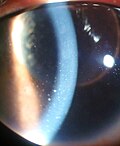| Keratic precipitate | |
|---|---|
 | |
| Keratic precipitate due to Vogt-Koyanagi-Harada Disease | |
| Specialty | Ophthalmology |
Keratic precipitate (KP) is an inflammatory cellular deposit seen on corneal endothelium. Acute KPs are white and round in shape whereas old KPs are faded and irregular in shape. Mutton-fat KPs are large in shape and are greasy-white in color and are formed from macrophages and epithelioid cells. They are indicative of inflammatory disease. [1] Mutton fat KPs are due to granulomatous iridocyclitis. [2] Another variant called red KPs may be seen in hemorrhagic uveitis.[ citation needed ]